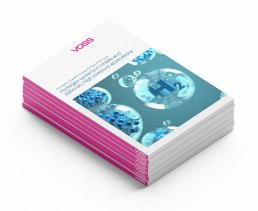Ever since Carl Benz designed the first automobile at the end of the 19th century, the automotive industry has been in a constant state of change. Changes have been seen from the VW Beetle to the “Eight Golf” and from the combustion engine to the hydrogen-based fuel cell. The use of hydrogen for private cars has been hotly debated for years. There is no doubt that the energy carrier is the sustainable alternative to the combustion engine, but there are also disadvantages compared to battery-powered electric motors. In any case, safe and reliable connection technology is what is in demand. To this end, VOSS is developing ready-to-install line systems and ready-assembled plug-and-play assemblies that secure the transport and storage of H2.
The development of hydrogen as an energy carrier is generating increasingly more interest. The current status suggests that the alternative propulsion option is particularly recommended for the sustainable operation of heavy commercial vehicles. The reason is that a conventional battery drive is unsuitable for long distances due to the weight of the battery packs and the resulting total weight of the vehicles. In addition, H2 technology can be used in emergency power generators or refrigerated trucks. But as an element with the smallest molecules, gaseous hydrogen is highly volatile. As a result, the requirements placed on transport and storage systems are increasing, especially at high pressures and fluctuating temperatures.
In the automotive industry in particular, the material used must be carefully selected and expertly processed. This applies to high-pressure applications in storage tanks as well as to medium and low-pressure lines in fuel cells. This is where the VOSS Group comes into play: We develop high-density tube and coupling systems in series production as well as valve technology for hydrogen applications. Our expertise in dealing with technically tight connection technology allows us to find customer-oriented solutions for the various H2 systems in the automotive industry.
The H2 fuel cell: this is how the transportation to the stack works
The design of an H2 drive requires a deft hand, since the volatile gas escapes upwards within seconds on contact with air. On top of that, the mixture of water and oxygen is highly flammable. That is why even the slightest leakage must be securely prevented. In automotive hydrogen applications, there are high, medium and low pressure ranges. In the tank, hydrogen is stored at a pressure of up to 700 bar. Consequently, a wide variety of valves are required to transport it to the low-pressure area of the fuel cell. Curved stainless steel tubes in combination with our VOSS Lok40 coupling system ensure the safe connection of all valves. The pressure is regulated with the aid of shut-off valves and a pressure control unit with sensors. Non-return valves facilitate the controlled flow towards the fuel cell and medium and low pressure lines ultimately transport the H2 to the fuel cell stack. Upon arrival, the hydrogen reacts with the oxygen supplied. With the electrical energy thus generated, the vehicle can finally drive off. The emerging waste products, such as water and nitrogen, escape via purge and drain valves. The VOSS product range also includes special purge and drain lines, which consist of the 246NX coupling system in combination with a material-locking connection to the plastic pipe. Depending on the customer's specifications, this cable can also be electrically heated to ensure the purge and drain function at all times regardless of the temperature. The temperature of the fuel cell is controlled by the thermal management system, for which VOSS supplies ready-to-install cables and valves to transport and distribute the cooling water.
System-solution approach in the automotive industry
For the transition from storage to complete system, we use our metal-sealing evergreen - the VOSS Lok40 coupling system. Suitable for all pressure ranges and the transport of gaseous and liquid substances, it creates the high-density connection required for handling. This is primarily ensured by the combination of tube contour and screwed coupling piece along with the high level of assembly reliability. The valves used come from our partner HypTec and, with the help of coordinated contours, form the perfect synergy with VOSS Lok40.
In addition to the high-pressure range with the VOSS Lok40 coupling system, VOSS works in the medium and low-pressure ranges as well as in thermal management with various plug-in systems. These are specially designed for the respective application. For the medium and low-pressure range, the 246DS quick connect system with a double seal on the connector and an additional O-ring on the mandrel profile is used in conjunction with multilayer plastic tubes. The 270DL and 271DL quick connect systems are particularly suitable when used for buffer battery cooling. The systems have been specially designed for tight installation spaces and, despite their compactness, have a double lock function. For thermal management requirements with larger flow rates, VOSS relies on the well-known 246NX quick connect system. This creates a deliverable, complete solution.
Especially in the hydrogen sector, VOSS stands for systems expertise and the goal of standardizing and industrializing systems in order to bring them to market maturity. We are experts in developing and producing customer-specific system solutions for both mobile and stationary applications. We serve the entire spectrum along the hydrogen value chain: starting with the production of hydrogen, such as electrolysis, through the storage and transportation of hydrogen and even distribution of hydrogen to the end user. This also includes the fuel cell itself, where thermal management is an important field of application. VOSS designs solutions tailored to individual customer requirements: Closures, ready-to-install cables, non-return, tank, pressure control and shut-off valves (among others), sensors, Tank Bosses and many more. Customers and users clearly benefit from the system expertise of the entire VOSS Group.
Would you like to learn more about H2?
Our free Whitepaper „The World in Transition: Hydrogen as the energy carrier of the future. Hydrogen systems for mobile and stationary high-pressure applications“ illustrates the many different potential applications for hydrogen, and discusses the current state of the art.
